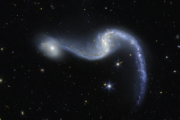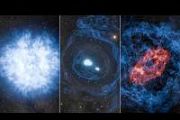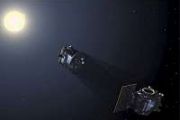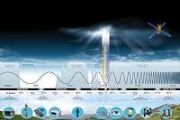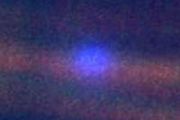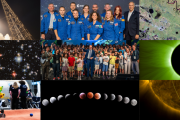
Copernical Team
Snowball Earth might have been a slushball
 At least five ice ages have befallen Earth, including one 635 million years ago that created glaciers from pole to pole.
Called the Marinoan Ice Age, it's named for the part of Australia where geologic evidence was first collected in the 1970s.
Scientists say the Marinoan Ice Age was one of the most extreme in the planet's history, creating glacial ice that persisted for 15 million y
At least five ice ages have befallen Earth, including one 635 million years ago that created glaciers from pole to pole.
Called the Marinoan Ice Age, it's named for the part of Australia where geologic evidence was first collected in the 1970s.
Scientists say the Marinoan Ice Age was one of the most extreme in the planet's history, creating glacial ice that persisted for 15 million y 13 volcanoes seen from space
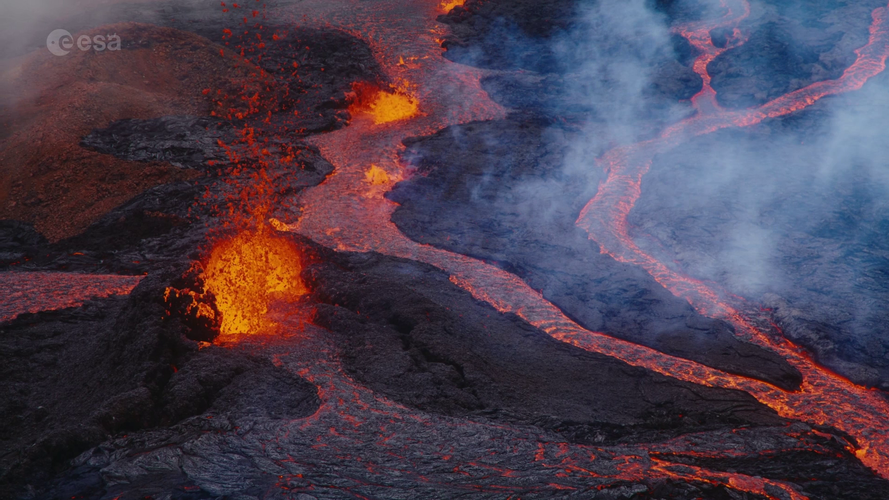 Video:
00:12:09
Video:
00:12:09
Have you ever wondered what a volcano looks like from space? Today, we’re counting down our picks of the most impressive volcanoes around the world – captured by satellites. Our countdown includes Mount Fuji, Mount Mayon and Mount Vesuvius. Satellites orbiting 800 km above us can monitor volcanoes. They can provide real-time data on volcanic activity and can even help disaster response efforts post-eruption.
NTT and SES offer satellite-based Edge and Private 5G network solutions
 NTT Ltd., a leading global IT infrastructure and services company, and SES, a leading global content connectivity service provider via satellite, today announced a multi-year partnership to use SES satellites to deliver NTT's Edge as a Service to enterprise customers. The collaboration will bring together NTT's expertise in networking and enterprise managed services with SES's unique satellite c
NTT Ltd., a leading global IT infrastructure and services company, and SES, a leading global content connectivity service provider via satellite, today announced a multi-year partnership to use SES satellites to deliver NTT's Edge as a Service to enterprise customers. The collaboration will bring together NTT's expertise in networking and enterprise managed services with SES's unique satellite c SmartSat funds research projects for Space Qualification Mission Waratah Seed
 SmartSat Cooperative Research Centre (CRC), Australia's largest space research centre, is committing over AU$1 million to support the development of new space technology that will be tested in space as payloads on the Waratah Seed WS-1 (Waratah Seed) spacecraft, Australia's first space qualification-focused ride-share mission, due to take its maiden flight later in 2023. The SmartSat NSW Node an
SmartSat Cooperative Research Centre (CRC), Australia's largest space research centre, is committing over AU$1 million to support the development of new space technology that will be tested in space as payloads on the Waratah Seed WS-1 (Waratah Seed) spacecraft, Australia's first space qualification-focused ride-share mission, due to take its maiden flight later in 2023. The SmartSat NSW Node an Safran to provide GNSS simulation solutions for Xona's LEO constellation
 Orolia, a Safran Electronics and Defense company, has partnered with Xona Space Systems to develop support for Xona's Low-Earth-Orbit (LEO) constellation and navigation signals in its Skydel-powered simulation and testing products. Xona is developing PULSAR - a high-performance positioning, navigation, and timing (PNT) service enabled by a commercial constellation of dedicated LEO satellites.
Orolia, a Safran Electronics and Defense company, has partnered with Xona Space Systems to develop support for Xona's Low-Earth-Orbit (LEO) constellation and navigation signals in its Skydel-powered simulation and testing products. Xona is developing PULSAR - a high-performance positioning, navigation, and timing (PNT) service enabled by a commercial constellation of dedicated LEO satellites. Juice testing - down to the wire
 Preparing the Juice mission to Jupiter has involved testing for all kinds of contingencies, down to the smallest of scales. This microscopic view shows surface damage to a tiny silver interconnector after being exposed to erosive atomic oxygen known to be found surrounding Jupiter's moon Ganymede.
Due to launch on 13 April to begin an eight-year journey to the largest planet in the Solar S
Preparing the Juice mission to Jupiter has involved testing for all kinds of contingencies, down to the smallest of scales. This microscopic view shows surface damage to a tiny silver interconnector after being exposed to erosive atomic oxygen known to be found surrounding Jupiter's moon Ganymede.
Due to launch on 13 April to begin an eight-year journey to the largest planet in the Solar S NASA's TEMPO spacecraft hitched a ride with Intelsat's 40e satellite on a SpaceX rocket
 SpaceX's Falcon 9 rocket blasted off from Space Launch Complex 40 (SLC-40), Cape Canaveral Space Force Station (CCSFS), Florida, on Friday, April 7th, at 12:30 a.m. EDT, with the Intelsat 40e (IS-40e), a high-throughput geostationary communications satellite built by Maxar Technologies and operated by Intelsat, while hosting NASA's TEMPO spacecraft.
Intelsat 40e will be positioned at 91 de
SpaceX's Falcon 9 rocket blasted off from Space Launch Complex 40 (SLC-40), Cape Canaveral Space Force Station (CCSFS), Florida, on Friday, April 7th, at 12:30 a.m. EDT, with the Intelsat 40e (IS-40e), a high-throughput geostationary communications satellite built by Maxar Technologies and operated by Intelsat, while hosting NASA's TEMPO spacecraft.
Intelsat 40e will be positioned at 91 de China's inland space launch site advances commercial services
 The Jiuquan Satellite Launch Center, which is currently China's only site for launching manned spacecraft into orbit, is looking to tap into the burgeoning commercial market by offering more services and stronger capabilities.
Located in northwest China's Gobi Desert, the Jiuquan launch center has carried out numerous space missions since its establishment in 1958. It frequented media Chin
The Jiuquan Satellite Launch Center, which is currently China's only site for launching manned spacecraft into orbit, is looking to tap into the burgeoning commercial market by offering more services and stronger capabilities.
Located in northwest China's Gobi Desert, the Jiuquan launch center has carried out numerous space missions since its establishment in 1958. It frequented media Chin Twinkling stars fuel interstellar dust
 Of the many different kinds of stars, asymptotic giant branch (AGB) stars, usually slightly larger and older than our own sun, are known producers of interstellar dust. Dusty AGBs are particularly prominent producers of dust, and the light they shine happens to vary widely. For the first time, a long-period survey has found the variable intensity of dusty AGBs coincides with variations in the am
Of the many different kinds of stars, asymptotic giant branch (AGB) stars, usually slightly larger and older than our own sun, are known producers of interstellar dust. Dusty AGBs are particularly prominent producers of dust, and the light they shine happens to vary widely. For the first time, a long-period survey has found the variable intensity of dusty AGBs coincides with variations in the am Historic nebula seen like never before with NASA's IXPE
 On Feb. 22, 1971, a sounding rocket lifted off from Wallops Island, Virginia, with specialized sensors aimed at the Crab Nebula, a bright cosmic object 6,500 light-years away. In those days, before recovering physical tapes from the experiment, scientists first received scientific data on a strip chart recorder, a device that printed signals on paper. Astronomer Martin Weisskopf and his colleagu
On Feb. 22, 1971, a sounding rocket lifted off from Wallops Island, Virginia, with specialized sensors aimed at the Crab Nebula, a bright cosmic object 6,500 light-years away. In those days, before recovering physical tapes from the experiment, scientists first received scientific data on a strip chart recorder, a device that printed signals on paper. Astronomer Martin Weisskopf and his colleagu 











